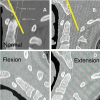Early Occipitocervical Fusion Surgery in a Rare Clinical Encounter of Non-traumatic Atlantooccipital Subluxation (AOS) in Down Syndrome (Trisomy 21)
- PMID: 39318904
- PMCID: PMC11420997
- DOI: 10.7759/cureus.67713
Early Occipitocervical Fusion Surgery in a Rare Clinical Encounter of Non-traumatic Atlantooccipital Subluxation (AOS) in Down Syndrome (Trisomy 21)
Abstract
Subluxation of the atlantooccipital joint in patients with underlying Down syndrome is an extremely rare orthopedic condition. The condition can pose life-threatening risks if not promptly diagnosed and treated in the early stage. Yet, there have been documented cases of survival following atlantooccipital subluxation or dislocation. Atlantooccipital subluxation (AOS) is usually identified during screening in children with Down syndrome for atlantoaxial subluxation (AAS). Therefore, careful evaluation of the atlantooccipital joint from radiographs is also essential. It is crucial to emphasize the clinical significance of AOS. Here the authors present the case of a fifteen-year-old girl with underlying Down syndrome (trisomy 21) who survived a sudden onset of non-traumatic atlantooccipital subluxation with spinal cord compression. There are only a few cases were reported in patients with Down syndrome (trisomy 21) and only two cases with surgically treated atlantooccipital (C0C1) subluxation have been reported. This case is of particular interest as it represents the first reported case of atlantooccipital (C0C1) subluxation with spinal cord compression in Down syndrome that underwent occipitocervical fusion surgery during the acute presentation, resulting in significant neurological recovery. Her neurology symptoms and physical functions showed remarkable improvement post-surgery, and she is doing well at the one-year follow-up in the clinic. Early surgery during acute presentation in this case resulted in good surgical outcomes and improved patient quality of life.
Keywords: atlanto-axial subluxation; atlanto-occipital c2-c3 fusion; cervical spine alignment; cervical spine anomalies; down's syndrome; occipito-cervical fusion surgery; pediatric cervical spine; pediatric spine surgery; spine and pediatrics orthopedics; trisomy of 21.
Copyright © 2024, Ng et al.
Conflict of interest statement
Human subjects: Consent was obtained or waived by all participants in this study. Conflicts of interest: In compliance with the ICMJE uniform disclosure form, all authors declare the following: Payment/services info: All authors have declared that no financial support was received from any organization for the submitted work. Financial relationships: All authors have declared that they have no financial relationships at present or within the previous three years with any organizations that might have an interest in the submitted work. Other relationships: All authors have declared that there are no other relationships or activities that could appear to have influenced the submitted work.
Figures









Similar articles
-
Atlantooccipital subluxation in a neonate with Down's syndrome. Case report and review of the literature.Pediatr Neurosurg. 1994;21(1):55-8. doi: 10.1159/000120815. Pediatr Neurosurg. 1994. PMID: 7947311
-
Combined traumatic atlantooccipital and atlantoaxial articulation instability: a case report with survival.Eur Spine J. 2014 May;23 Suppl 2:242-7. doi: 10.1007/s00586-013-3112-y. Epub 2013 Dec 1. Eur Spine J. 2014. PMID: 24292344
-
Chronic posterior atlantoaxial subluxation associated with os odontoideum: a rare condition. A case report and literature review.Spinal Cord Ser Cases. 2018 Dec 19;4:110. doi: 10.1038/s41394-018-0143-y. eCollection 2018. Spinal Cord Ser Cases. 2018. PMID: 30588336 Free PMC article.
-
Pediatric cervical kyphosis in the MRI era (1984-2008) with long-term follow up: literature review.Childs Nerv Syst. 2022 Feb;38(2):361-377. doi: 10.1007/s00381-021-05409-z. Epub 2021 Nov 22. Childs Nerv Syst. 2022. PMID: 34806157 Review.
-
Cervical spine manifestations of rheumatoid arthritis: a review.Neurosurg Rev. 2021 Aug;44(4):1957-1965. doi: 10.1007/s10143-020-01412-1. Epub 2020 Oct 10. Neurosurg Rev. 2021. PMID: 33037539 Review.
Cited by
-
The Halo Vest Immobilization for Craniocervical Junction Tuberculosis: A Comparison of Treatment Options.Orthop Surg. 2025 Jun;17(6):1732-1741. doi: 10.1111/os.70047. Epub 2025 May 1. Orthop Surg. 2025. PMID: 40312982 Free PMC article.
-
A challenging diagnosis in a Down syndrome child presenting with hemiparesis: atlantoaxial subluxation.Sudan J Paediatr. 2025;25(1):62-65. doi: 10.24911/SJP.106-1736272418. Sudan J Paediatr. 2025. PMID: 40718738 Free PMC article.
References
-
- Cervical-spine instability in children with Down syndrome (trisomy 21) Semine AA, Ertel AN, Goldberg MJ, Bull MJ. J Bone Joint Surg Am. 1978;60:649–652. - PubMed
-
- Traumatic anterior atlanto-occipital dislocation. Powers B, Miller MD, Kramer RS, Martinez S, Gehweiler JA Jr. Neurosurgery. 1979;4:12–17. - PubMed
-
- Atlanto-occipital and atlanto-axial dislocations with spinal cord compression in Down's syndrome: a case report and review of the literature. Hungerford GD, Akkaraju V, Rawe SE, Young GF. Br J Radiol. 1981;54:758–761. - PubMed
-
- Asymptomatic occipito-atlantal instability in Down syndrome (trisomy 21). Report of two cases in children. Brooke DC, Burkus JK, Benson DR. https://pubmed.ncbi.nlm.nih.gov/2948963/ J Bone Joint Surg Am. 1987;69:293–295. - PubMed
Publication types
LinkOut - more resources
Full Text Sources
Miscellaneous
